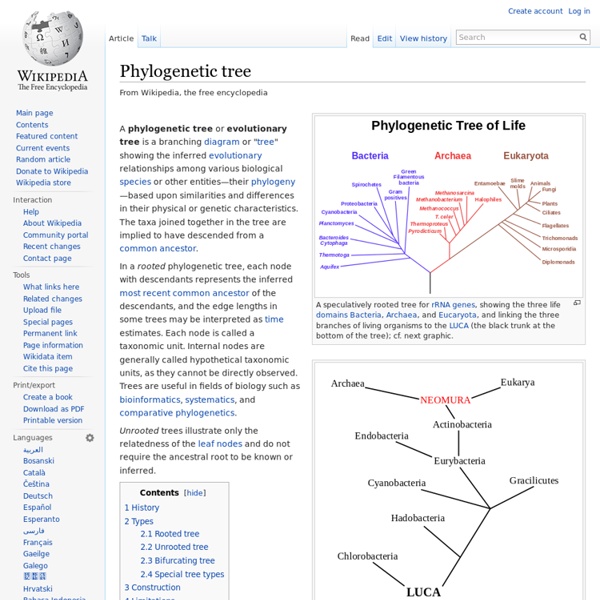Phylogenetic tree

Tree structure
A tree structure showing the possible hierarchical organization of an encyclopedia. The original Encyclopédie used a tree diagram to show the way in which its subjects were ordered. A tree structure is a way of representing the hierarchical nature of a structure in a graphical form. It is named a "tree structure" because the classic representation resembles a tree, even though the chart is generally upside down compared to an actual tree, with the "root" at the top and the "leaves" at the bottom. Terminology and properties[edit] The names of relationships between nodes are modeled after family relations. A node's "parent" is a node one step higher in the hierarchy (i.e. closer to the root node) and lying on the same branch." In the example, "encyclopedia" is the parent of "science" and "culture", its children. Examples of tree structures[edit] Representing trees[edit] There are many ways of visually representing tree structures. Classical node-link diagrams[edit] Nested sets[edit]
this is onformative a studio for generative design.
M.A. Thesis
Visual tools for the socio–semantic web This thesis contributes to a new discipline of science: web science, as introduced by Tim Berners-Lee and others in 2006. Designers, computer scientists, sociologists, cognitive scientists, psychologists etc. have individual perspectives on the complex and rapidly evolving interplay of technological and social infrastructure and human society. Master’s Thesis Interface Design Programme University of Applied Sciences Potsdam Moritz Stefaner, June 2007 Supervisors: Prof. Best Masters Thesis at FH Potsdam in 2007 Analysis The analytical part defines the technological and social context of interface design for personal information management applications. These findings shed a new light on our understanding of content, hypertext and metadata. Guidelines I proceed by deriving design maximes from these observations: These guidelines and hypotheses from the analytical part were both generated and illustrated with interactive visualizations: Elastic tag maps
Data Visualization: Modern Approaches
Revised Graphic Organizers Make Mapping Out Ideas Easy—and Savable!
Join us on Facebook to get the latest news and updates. Become a Fan ReadWriteThink couldn't publish all of this great content without literacy experts to write and review for us. If you've got lessons plans, activities, or other ideas you'd like to contribute, we'd love to hear from you. More Home › About Us › News News | August 17, 2011 Recently revised, three online interactive graphic organizers help students map out their writing ideas or organize information they have learned. Try the new save capability with your students using any one of these interactive mapping tools. Students often have trouble getting started when asked to write an essay. You can’t compare apples to oranges. Still need some convincing? For a short tutorial on how to use the new save capability in select Student Interactives, see ReadWriteThink ReView: Saving Work With the Student Interactives.
Walrus - Graph Visualization Tool
Source Code Available The source code to Walrus is now available under the GNU GPL. You may download the source code below. Description Walrus is a tool for interactively visualizing large directed graphs in three-dimensional space. Walrus computes its layout based on a user-supplied spanning tree. Walrus uses 3D hyperbolic geometry to display graphs under a fisheye-like distortion. Walrus is being developed by Young Hyun at CAIDA. Applicability Please note that Walrus currently has the following requirements, restrictions, or limitations which may render it unsuitable for a given problem domain or dataset: Only directed graphs are supported.Only connected graphs with reachable nodes are supported. Galleries The following galleries show graphs of various sizes and complexity. Implemented Features Features Under Consideration more options for coloring objects (such as with a perceptually uniform colorscale)filtering and other interactive processing Requirements Download Changes References
Introduction to Circos, Features and Uses // CIRCOS Circular Genome Data Visualization
Infographics news
Information design
Information design is the practice of presenting information in a way that fosters efficient and effective understanding of it. The term has come to be used specifically for graphic design for displaying information effectively, rather than just attractively or for artistic expression. Information design is closely related to the field of data visualization and is often taught as part of graphic design courses.[1] Etymology[edit] The term 'information design' emerged as a multidisciplinary area of study in the 1970s. In 1982, Edward Tufte produced a book on information design called The Visual Display of Quantitative Information. The term information graphics tends to be used by those primarily concerned with diagramming and display of quantitative information. In technical communication, information design refers to creating an information structure for a set of information aimed at specified audiences. Early examples[edit] Applications[edit] See also[edit] References[edit]
Related:
Related:



